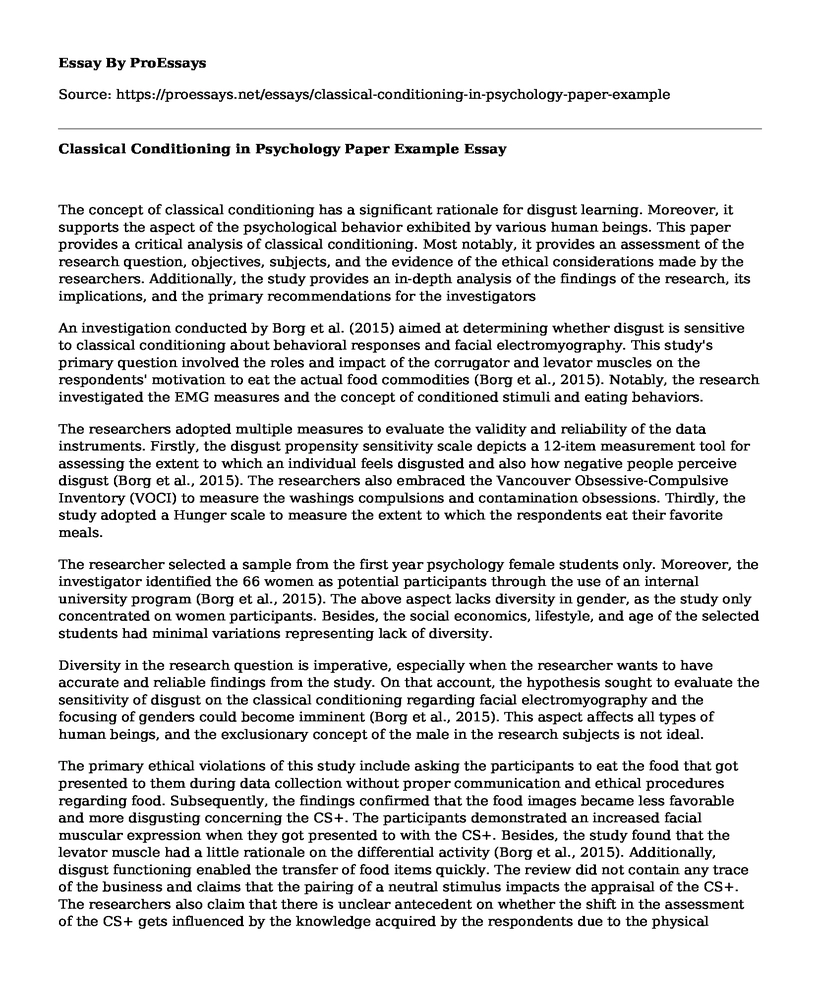The concept of classical conditioning has a significant rationale for disgust learning. Moreover, it supports the aspect of the psychological behavior exhibited by various human beings. This paper provides a critical analysis of classical conditioning. Most notably, it provides an assessment of the research question, objectives, subjects, and the evidence of the ethical considerations made by the researchers. Additionally, the study provides an in-depth analysis of the findings of the research, its implications, and the primary recommendations for the investigators
An investigation conducted by Borg et al. (2015) aimed at determining whether disgust is sensitive to classical conditioning about behavioral responses and facial electromyography. This study's primary question involved the roles and impact of the corrugator and levator muscles on the respondents' motivation to eat the actual food commodities (Borg et al., 2015). Notably, the research investigated the EMG measures and the concept of conditioned stimuli and eating behaviors.
The researchers adopted multiple measures to evaluate the validity and reliability of the data instruments. Firstly, the disgust propensity sensitivity scale depicts a 12-item measurement tool for assessing the extent to which an individual feels disgusted and also how negative people perceive disgust (Borg et al., 2015). The researchers also embraced the Vancouver Obsessive-Compulsive Inventory (VOCI) to measure the washings compulsions and contamination obsessions. Thirdly, the study adopted a Hunger scale to measure the extent to which the respondents eat their favorite meals.
The researcher selected a sample from the first year psychology female students only. Moreover, the investigator identified the 66 women as potential participants through the use of an internal university program (Borg et al., 2015). The above aspect lacks diversity in gender, as the study only concentrated on women participants. Besides, the social economics, lifestyle, and age of the selected students had minimal variations representing lack of diversity.
Diversity in the research question is imperative, especially when the researcher wants to have accurate and reliable findings from the study. On that account, the hypothesis sought to evaluate the sensitivity of disgust on the classical conditioning regarding facial electromyography and the focusing of genders could become imminent (Borg et al., 2015). This aspect affects all types of human beings, and the exclusionary concept of the male in the research subjects is not ideal.
The primary ethical violations of this study include asking the participants to eat the food that got presented to them during data collection without proper communication and ethical procedures regarding food. Subsequently, the findings confirmed that the food images became less favorable and more disgusting concerning the CS+. The participants demonstrated an increased facial muscular expression when they got presented to with the CS+. Besides, the study found that the levator muscle had a little rationale on the differential activity (Borg et al., 2015). Additionally, disgust functioning enabled the transfer of food items quickly. The review did not contain any trace of the business and claims that the pairing of a neutral stimulus impacts the appraisal of the CS+. The researchers also claim that there is unclear antecedent on whether the shift in the assessment of the CS+ gets influenced by the knowledge acquired by the respondents due to the physical contact.
The primary implication of the study involves the rationale of the disgust conditioning behavior among human beings in response to eating habits. Moreover, it can be noted from the research that disgust aversive conditioning leads to a reduced willingness to eat food items used by CS+ and increased disgust ratings (Borg et al., 2015). The researchers provide useful information regarding the rationale of disgust conditioning and the behavioral patterns of eating. Further research could focus on post-acquisition group and the appraisal of the CS+. The main point of concern involves the response of the corrugator muscle in eating behavior. Furthermore, the investigators could have adopted a relatively larger sample and diversify the research subjects to draw more conclusions on the classical conditioning. Additionally, the researcher did a remarkable job by adopting the psychological approaches in evaluating disgust and classical conditioning.
Conclusion
In summary, classical conditioning mentioned here has a great significance in disgust. The paper notes that multiple measures got adopted for evaluating the data instruments. The research included female students, and ethical violations involved the aspect of compelling the participants to eat food. Above all, the study paper provides an analysis of disgust conditioning during eating.
Reference
Borg, C. et al. (2015). Is disgust sensitive to classical conditioning as indexed by facial electromyography and behavioral responses?. Cognition and Emotion, 30(4), pp. 669-686.
Cite this page
Classical Conditioning in Psychology Paper Example. (2022, Oct 08). Retrieved from https://proessays.net/essays/classical-conditioning-in-psychology-paper-example
If you are the original author of this essay and no longer wish to have it published on the ProEssays website, please click below to request its removal:
- Stumbling on Happines
- Psychology Paper Sample: How Parental Verbal Abuse Affects Child Personality and Social Behavior
- 25 Things About Me - A Personal Essay Example
- Nurses Role in the Recovery of Soldiers With PTSD Essay
- Essay Sample on Abnormalities: Deviations from Social Norms
- Forensic Analysis of Mr. M: Psychopathy, Thought Disorder, Delusion - Essay Sample
- Essay on Humans Are Good: Exploring Humanistic Approaches to Psychotherapy







